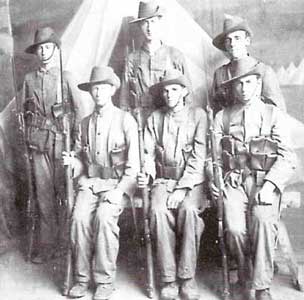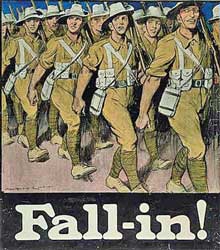Infantry Equipment, Australian Pattern (Leather)
Getting the Digger Ready to Fight - or - The Equipment formerly known as "Pattern 1915"
The Terminology
 When Karkee Web first appeared, this section began with these sentences:
When Karkee Web first appeared, this section began with these sentences:
Not nearly enough information has been published about this type of infantry equipment. Even the correct nomenclature is in question.
That proved to be a massive understatement.
In his book on bayonet frogs, Anthony Carter says that the correct name is "Australian Pattern 1915 Chrome Leather Equipment", while in his article in Rick Landers's Saddle Up!, Alan Simpson calls it "The Infantry Equipment, Australian Pattern 1915". Karkee Web made the decision to follow Simpson and refer to this pattern as The Infantry Equipment, Australian Pattern 1915. We did, let it be noted, alert the reader that this term may well be a collector's designation only and not an official one.
If you've noticed the title at the top of this page, you'll see that we've had a re-think. The Australian contingent of the Karkee Web Research Team is both active and very knowledgeable. The research into the Australian primary source documentation is ongoing, but to date not one piece of original material has been found that used the term "Pattern 1915".
There is no doubt that "Pattern 1915" is and almost certainly will continue to be the collector's term for this equipment. Even so respected an institution as the Australian War Memorial uses "Pattern 1915 Australian Leather Equipment" to describe it. In an email to Karkee researcher Peter Raftos, the AWM's Assistant Curator, Military Heraldry & Technology, Danielle Cassar, stated "our decision to use this term is not based on any official or military references. As you are aware there are many variations of this title used to describe the leather equipment and no definitive answer as to which is the ‘correct’ term. ‘Pattern 1915 Australian Leather Equipment’ is a simple yet descriptive term which we have chosen to use when cataloguing these items."
With the Australian War Memorial supporting the use of "Pattern 1915", it would not be too unreasonable for Karkee Web to continue with it as well. However, the word "pattern" has a very specific meaning in British and Empire military nomenclature, and at Karkee we try very hard to use the correct official terminology wherever possible. So far, the term Infantry Equipment, Australian Pattern (Leather) seems to be the most commonly used, although ... (Leather and Canvas) is encountered as well. Ms. Cassar's statement that "there are many variations of this title used to describe the leather equipment" is proving to be no less than correct.
For the present, Karkee Web is using Infantry Equipment, Australian Pattern (Leather) as the "official" nomenclature, and Australian Pattern as the shorter version. As previously noted, though, researches are continuing. It is entirely possible that something may turn up that will definitively answer the question once and for all. At some future date, we will post as many of the relevant official documents as we can.
Note: This is very definitely a work in progress. Expect more revisions in the coming weeks.
Infantry Equipment, Australian Pattern (Leather): Origins and Background
 At the start of the Great War, it was clear that Australia could not rely on Great Britain for its infantry's supply needs.. The home country did not have the manufacturing capacity to supply its own army's requirements - sending web equipment to Australia was out of the question.
At the start of the Great War, it was clear that Australia could not rely on Great Britain for its infantry's supply needs.. The home country did not have the manufacturing capacity to supply its own army's requirements - sending web equipment to Australia was out of the question.
Australia did not have the ability to manufacture cotton webbing, but there was plenty of leather. Cattle, sheep, and kangaroos were in plentiful supply, and the resourceful Australians set about reproducing W.E. Patt. '08 in leather. One source has reported that the developmental work on what would become Infantry Equipment, Australian Pattern (Leather) actually began well before the war, perhaps as early as 1912. There will be more on this soon.
Early versions, such as the one shown at the top of this page, had cartridge carriers that resemble leather waistcoats with Pattern 1903 style 15 round pouches mounted on them. Later, production versions looked much more like Patt. '08.
When Infantry Equipment, Australian Pattern (Leather) was put in service, it was found that the tongueless Twigg buckles slipped when wet. The British, when faced with the same problem with their Pattern 1914 Infantry Equipment, used conventional tongued belt buckles. The Australians, though, simply added a tongue to the Twigg style open buckle, creating a unique buckle found in no other type of infantry equipment. What's more, it worked. This fix notwithstanding, Australian Pattern Equipment was never judged as completely satisfactory, and in general Australian troops were resupplied with Patt. '08 when the reached the front in Europe. This was by no means universal, though. Period photos show diggers wearing Australian Pattern throughout the war, in all theaters. It is also worth noting that, at the start of the Second World War, Australia pulled its Australian Pattern Equipment out of stores and put it to use, in training and possible in combat as well. Not too bad, really, for an equipment that had a reputation as short-lived and unreliable.